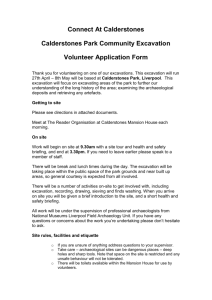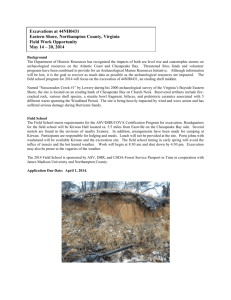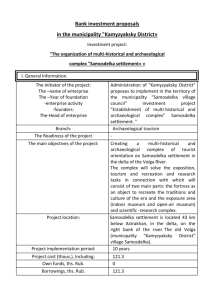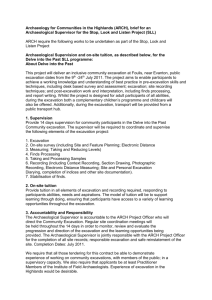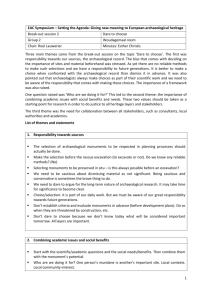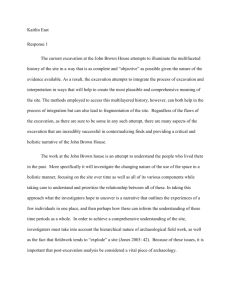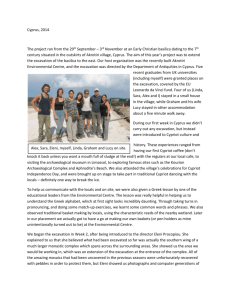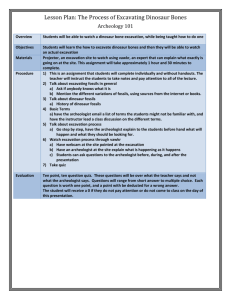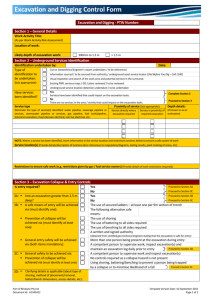to document.
advertisement
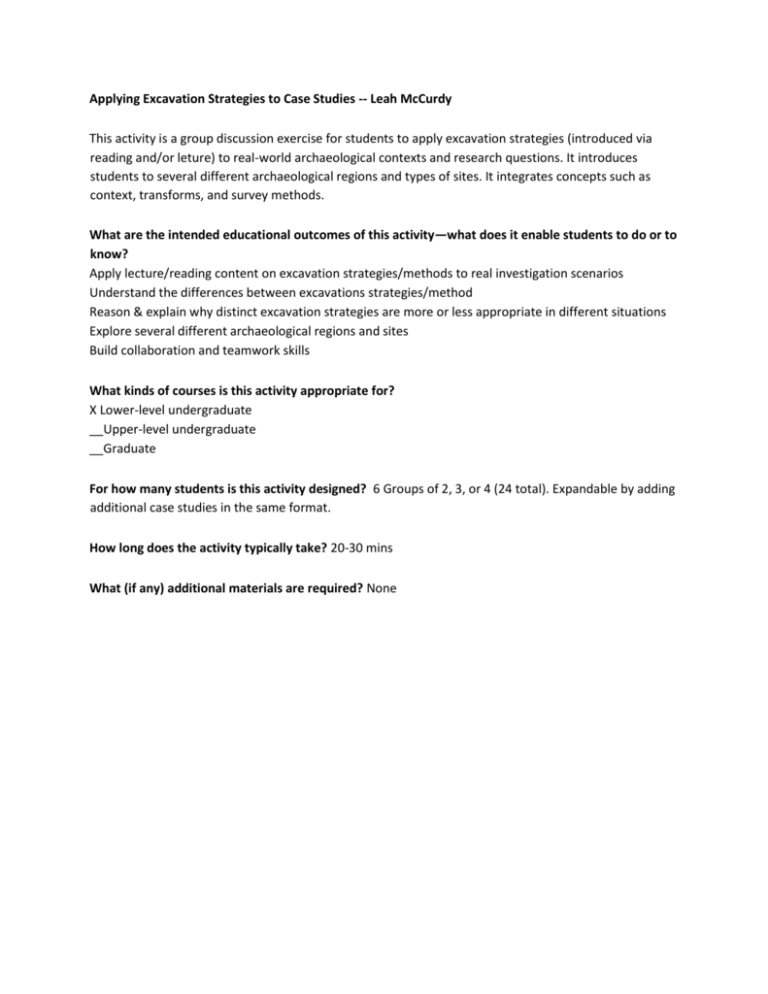
Applying Excavation Strategies to Case Studies -- Leah McCurdy This activity is a group discussion exercise for students to apply excavation strategies (introduced via reading and/or leture) to real-world archaeological contexts and research questions. It introduces students to several different archaeological regions and types of sites. It integrates concepts such as context, transforms, and survey methods. What are the intended educational outcomes of this activity—what does it enable students to do or to know? Apply lecture/reading content on excavation strategies/methods to real investigation scenarios Understand the differences between excavations strategies/method Reason & explain why distinct excavation strategies are more or less appropriate in different situations Explore several different archaeological regions and sites Build collaboration and teamwork skills What kinds of courses is this activity appropriate for? X Lower-level undergraduate __Upper-level undergraduate __Graduate For how many students is this activity designed? 6 Groups of 2, 3, or 4 (24 total). Expandable by adding additional case studies in the same format. How long does the activity typically take? 20-30 mins What (if any) additional materials are required? None EXCAVATION STRATEGIES To explore the variety of excavation strategies employed by archaeologists, we will be discussing several different research case studies. You will divide into groups and, through discussion, determine which of the following excavation strategies introduced in class would be the most appropriate for each case. - Test pitting - Trenching - Tunneling - Clearing/Stripping - Area Excavations Each group will be assigned one case study. You will have ten minutes to discuss the information provided, ask questions, and make a determination about which strategy you would employ. THINGS TO CONSIDER: - Remember how important research questions are to archaeological investigations. The research question provided for each case study should be one of the key pieces of information that guides your determination. - Make sure to read all information carefully. There may be details that should inform whether certain excavation strategies would even be feasible in certain conditions. - Your group will be presenting your determination to the class, along with a synopsis of the case study information. Make notes on the reasoning for your determination. Additional Discussion Questions: 1. Imagine you implemented the excavation strategy your group determined was most appropriate in this context. What sort of data (artifacts, ecofacts, and/or features) would you expect to find? 2. Would you expect to encounter any transformations to the archaeological record during these excavations? Discuss potential natural and cultural transformations. 3. Discuss what sorts of distinct contexts you might encounter in these investigations. What characteristics would signify these distinct contexts? [The following information is provided to students in handouts with images. Add images, maps, and other figures are you see fit.] CASE STUDY 1: MAYA MONUMENTS Research Question: What is the construction history of this Maya building? Information learned from Literature Review: The Maya culture has been divided into three major periods: the Preclassic (3000 BC – 200 AD), the Classic (200 – 1000 AD), and the Postclassic (1000 – 1400 AD). During the later periods, the Maya built on top of earlier buildings. As a result, Maya buildings are like onions with multiple successive layers. Data Collection: Our preliminary survey of this building indicates that the phase visible now dates to the very end of the Classic period. Further, other buildings in the same complex have remnants of original Preclassic structures beneath the Classic period structures. CASE STUDY 2: NEOLITHIC ORKNEY Research Question: What daily activities did different households pursue in a Neolithic Orkney Island village just before sites started to be abandoned? Information from Literature Review: The Orkney Islands are part of Scotland and located at the northern tip of the country. The Neolithic period in the Orkney Islands dates between 3500 and 2000 B.C. Due to the coastal exposure of these small islands, the archaeological record is subject to erosion. These islands are only sparsely occupied today. Data Collection: Preliminary surface survey encountered Neolithic ceramics on the surface among exposed wall stones. LiDAR survey indicates that there is a very low density of occupation over time on the islands. CASE STUDY 3: SHINTO SHRINES Research Question: How did ancient Japanese people change the way they constructed important ritual buildings at Ise Shrine over time? Information from Literature Review: Ise Shrine has been an important ceremonial center for the Shinto religion in Japan since around 600 A.D. Building is a very important ritual practice in the Shinto religion and is dictated by re-building ceremonies that take place every twenty years. Each building in the Ise inner sanctuary (see the photo) is rebuilt in the same location during each re-building ceremony. Data Collection: Preliminary surface survey indicates that remains of previous building events are cleaned away very meticulously after every re-building. Ground penetrating radar shows that postholes from previous buildings remain beneath the level of the current buildings. CASE STUDY 4: GAULT CLOVIS Research Question: How did environmental change impact lithic tool production by ancient nomadic hunters camping at the Gault site between 10,000 and 12,000 years ago? Information from Literature Review: The Gault site is located near Round Rock, Texas. During the period when the Gault site was used as a temporary hunting camp by Paleoindians, there were many environmental changes including the cessation of an ice age and possible catastrophic events such as earthquakes. The Gault site is associated with a particular culture known as the Clovis culture that produced very distinct types of lithic tools (like those in the photo). Data Collection: Previous archaeologists have determined that there are “occupational floors” at the Gault site on which many lithic producers worked to create specific types of tools. These “occupational floors” have been discovered as separate and distinguishable stratigraphic layers in the main area of the site. CASE STUDY 5: MOHENJO DARO Research Question: How were public areas of Mohenjo Daro separated from private areas when it was first built? What role did water significance play in this separation? Information from Literature Review: Located in modern-day Pakistan, Mohenjo Daro was only occupied for a relatively short time, approximately 2600 – 1900 B.C. The city was constructed with a “master plan” that can be seen in the ruins today. The religion of this ancient city centered on water. Public baths were very important locations for cleansing rituals. Data Collection: Aerial photography and LiDAR reconnaissance reveal exposed urban patterns. We have identified several large open spaces, with deep rectangular features. These open spaces appear to be surrounded by smaller, contained spaces. CASE STUDY 6: WHALEBONE HOUSES Research Question: How did ancient Thule people of the Canadian Arctic use interior and exterior spaces differently when occupying whalebone houses during winter? Information from Literature Review: The Thule culture is the ancestor of modern Inuit cultures (formerly known as Eskimo) in arctic regions. Whalebone houses were constructed using multiple components of whale carcasses. These houses were occupied by up to ten people during the winter months after the summer hunting season. Data Collection: Systematic surface survey recovered large quantities of human-modified marine animal bone. We could not determine through survey alone whether spaces were interior or exterior.

